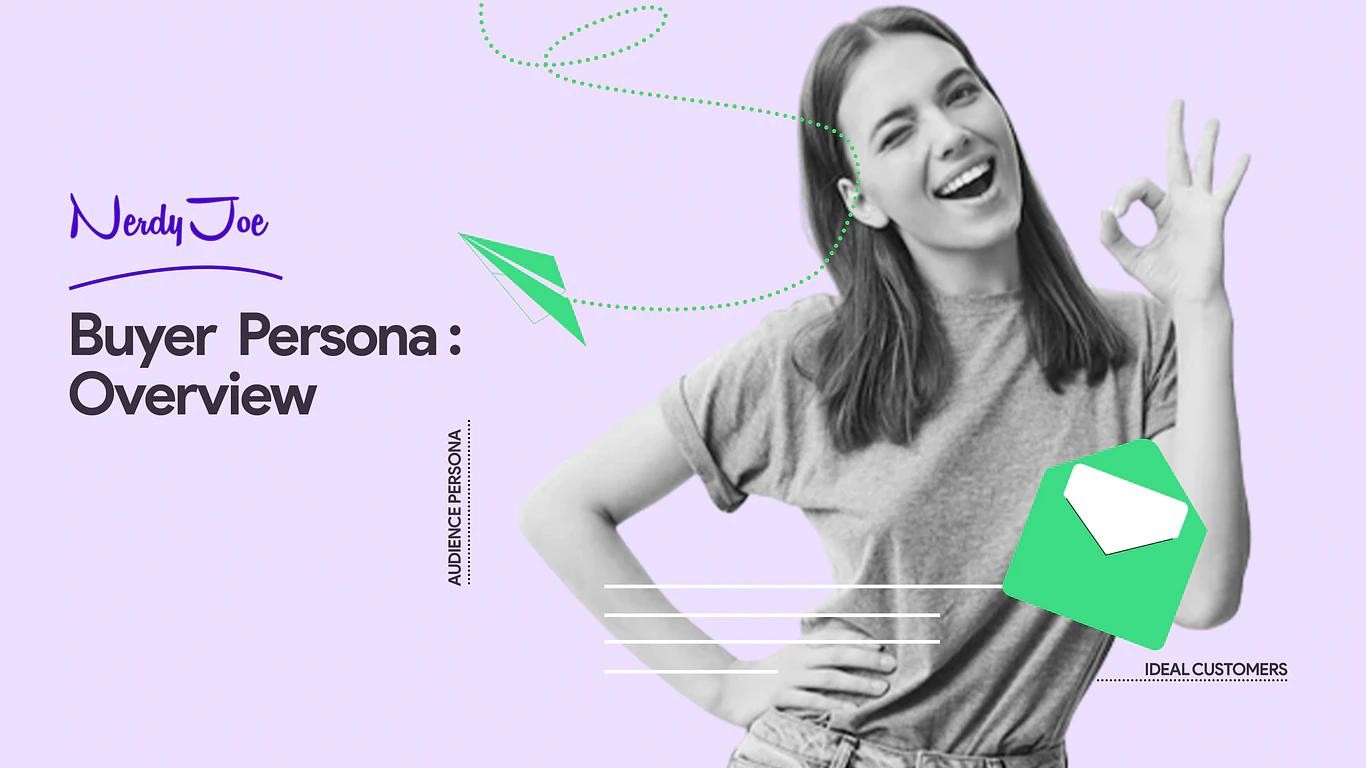
Segmenting and reaching the right audience is crucial in making your marketing efforts a success. How do you do this? The answer is the buyer persona.
Creating a buyer persona makes it possible to gather valuable insight to create relevant content that addresses your customer’s pain points, explores their motives, and achieves your goals.
In the email marketing world, research reveals that the use of a buyer persona increases the click-through rate by 14%, and boosts email conversion by 10%.
In this post,, you will learn essential details about buyer persona including how to create one.
What is a buyer persona?
A buyer persona is a semi-fictional representation of your ideal customers. It is created based on quantitative (e.g market research or surveys) and qualitative (e.g customer interviews) data about your existing customers.
For instance, if you deal with a shoe business, you can have a Stylish John, Practical Paula, and Discount Robert as your buyer personas.
Here, John might be the customer that loves to look good in new shoes at any cost, while Paula can be focused on finding long-lasting shoes, and Robert only buys when you have an ongoing promo, which is great for clearing out the previous merchandise.
Buyer personas help you better understand who your customers are and give you insights into what your buyers think about when doing business with you.
Based on this knowledge, you can align your marketing decisions to meet your buyer’s expectations and deal with anything relating to customer acquisition and retention.
Why is a buyer persona important?
Here are some reasons why you should consider buyer persona for your business.
1 – A buyer persona enables you to better understand your customers
Buyer personas enable you to have a deeper understanding of not only your existing customers but also the potential ones.
You will gain insights into their specific attitudes such as needs, wants, habits, preferred shipping methods, pain points, demographic information, and more.
By knowing these details about your customers, you can create valuable content they can relate to and will prompt them to engage with your business.
2 – A buyer persona helps you craft targeted Marketing
Buyer personas allow you to easily segment your audience into different groups. With this, you can send personalized, targeted content to each segment.
This personalization enables you to communicate with them in their language, create relevant content that meets their needs, and distribute the messages to them in their preferred channel.
Hence, you can target the right people in the right place, create long-term relationships with them, and generate better-quality leads.
3 – A buyer persona helps you improve efficiency
Once you know the persona that can lead to your ideal customers, you will know the leads your sales and marketing team should concentrate their focus on.
This improves efficiency within the company by preventing you from wasting time and effort on leads that won’t purchase from you.
In short, buyer personas enable you to identify the better customers you should allocate your time and money to without wasting much effort.
4 – A buyer persona helps you develops better products
Buyer personas enable you to focus on the right customers and develop future products that suit their needs.
Here, you can align your marketing decisions to what your customers want, and create products or services that will suit their needs.
How to create a buyer persona for email marketing in 5 steps (tips and strategies)
Creating a buyer persona has never been an easy task. Here are some useful tips that can help you when creating a buyer persona for email marketing.
1 – Understand your audience
The first step of the process is to have an in-depth understanding of who your customers are.
You can do this by conducting market research to gather various data about your existing customers.
The data collected will give you insights on how to craft and improve your email marketing campaigns, drive engagement, and ultimately increase sales.
There are many ways by which you can learn about your audience. You can use some analytics tools to discover customer demographics or online user behavior.
Or you can conduct surveys, questionnaires, or use interviews to elicit in-depth answers from your audience.
By obtaining these pieces of information, you will better understand who you need to reach and how to reach them effectively.
2 – Narrow down common details
After you have obtained the data, you can narrow down the results by finding common details you obtained from your subscribers.
Go through the details to select the most essential one that affects your relationship with your subscribers.
For instance, if the majority of your subscribers share similar challenges, this can be an important detail to note in your persona.
Narrowing down common details enables you to categorize all your potential clients with similar traits into a distinct set of buyer personas.
3 – Segment your audience
Now that you have narrowed down the common details, you should use those details in segmenting your subscribers.
You can do this by identifying people with different metrics such as their goals, their occupation, age, or more. Each metric represents different personas.
For instance, if your business is about fitness, you can have clients with different goals. Some may want to lose weight, while some may want to increase their muscles and weight.
Since they have different goals, you should create different personas for each segment. This helps you to craft relevant email contents that fit their needs and match their objectives.
4 – Develop email marketing strategies for each persona
After conducting research, narrowing down the common details, and segmenting your audience, you need to develop an email marketing strategy for each persona.
As an email marketer, you should outline different strategies that can engage your subscribers and achieve your email marketing objectives.
To do this, you can start by outlining the overall goals of your email marketing strategies. Is it to create brand awareness? Or do you want to increase conversion?
Then, determine the strategy you want to employ for each persona.
For instance, if a particular person only buys when you offer a discount, you can send a promotional email offering incentives to them at this time.
Developing the right email marketing strategy for each persona prevents you from sending irrelevant emails to each segment.
5 – Evaluate your campaigns
You can evaluate the effectiveness of your email marketing campaigns through key metrics. These metrics such as the open rate, click-through rate, or bounce rate, offer insights into how well you are performing.
For instance, when you notice that your emails have a high open rate or CTR, it implies that your emails are catching your subscribers’ attention.
On the other hand, if you notice that you get lots of bounce rates, you will have to determine the reasons why your subscribers are leaving your emails unopened.
Evaluating your campaigns enables you to gain insights into the level of success or failure of your email marketing strategies.
10 buyer persona questions to profile your customers
When profiling your customers, you may need to consider asking them some questions. This enables you to gain insights into who they are and how you can craft valuable content for them.
Some of these questions include:
Questions about personal background
1 – What are their demographics?
Obtaining demographic information is a great way to begin drafting your buyer persona. You get to have a clear picture of who they are. Some of the questions can be:
- How old is your customer?
- Are they single or married?
- Do they identify with a particular gender? If yes, specify it.
- Where do they live?
- What is their annual household income?
- Do they have children?
2 – What is their educational background?
You should have an understanding of the educational background of your audience, especially if it helps your business. Some of the questions can be:
- What level of education do they complete?
- Which school do they attend?
- What did they study?
3 – What is their career path like?
Obtaining and analyzing information about a customer’s career path has a lot to do with their decision-making process and their general worldview. Some of the questions can be:
- Has their career track been traditional?
- Did they switch to a different industry?
- Did they major in a subject that is similar to their current role?
Questions about their job
4 – What is your role? The title?
Asking this question can help you determine how much of their disposable income they can spend on various products or services. Some of the questions here can be:
- How long have you had this job and title?
- Are they individual contributors?
- Do they manage people?
- What tools do you use in your job?
- What skills do they have?
Questions about their challenges
5 – What are their challenges?
Your business exists because you are solving a problem for your audience. Try to understand how that problem affects their daily activities.
Go into more detail and highlight how the problems make them feel.
For instance, let’s say you are an arborist that sells your services directly to consumers. One of your personas may be people living in residential houses. What are their pain points?
They can have diseased or unwanted trees that can damage their property at any time, prompting them to remove them. Or they can have overgrown trees that need to be trimmed for aesthetic purposes.
Addressing these pain points enables your audience to realize the value of your business.
Questions about their goals
6 – What do they aim to achieve?
This question is crucial in highlighting how you can be of value. What is their primary goal? What is their secondary goal? Having an understanding of this enables your persona to overcome their challenges and achieve their goals with you.
Questions about their learning experience
7 – How do they learn?
If you are going to sell to your personas, you need to understand how they consume information. Do they read newspapers or magazines? Or perhaps, they love to go online? If they learn online, do they use Google? Or a social network?
8 – Which social networks or associations do they use?
You should know the platforms your buyers occasionally use and invest your time and efforts there. Identify the social network they often spend their time on, so that you can prioritize how to get to them.
Questions about their shopping preferences
9 – How do they like to shop?
The experience associated with purchasing your product should match your person’s expectations. Ask about how their sales experience feels like.
How much time do they expect to spend with a salesperson? What method do they use?
Do they prefer to shop in person or would they like to make orders over the phone or online?
10 – Describe a recent purchase
Ask your audience about what their recent purchase felt like. Was it good? What were their expectations?
If there are any objections to how they made a recent purchase or if there are reasons why they don’t like to buy from you, you can take note of them and educate your marketing team on how to solve the problems.
Email marketing buyer persona template
If you feel overwhelmed when creating a buyer persona, you can use a buyer persona template as a guide. Using a buyer persona template helps you to organize information and input every essential detail.
The template serves as an outline where you can fill in all the information you obtained from your research. Some of the information you may include are:
- Background details: It provides personal information such as your customer’s name, age, location, marital status, and occupation.
- Biography: These are a few sentences that show basic information such as your customer’s education, history, interests, and more.
- Interests: Here, you can specify your customer’s interests such as their hobbies.
- Challenges: You can list all your customer’s pain points and how it affects their daily lives.
- Goals: You can indicate their goals including professional and personal goals.
- Behavioral traits: You can include some behavioral traits such as the type of social media they use, their shopping behavior, and more.
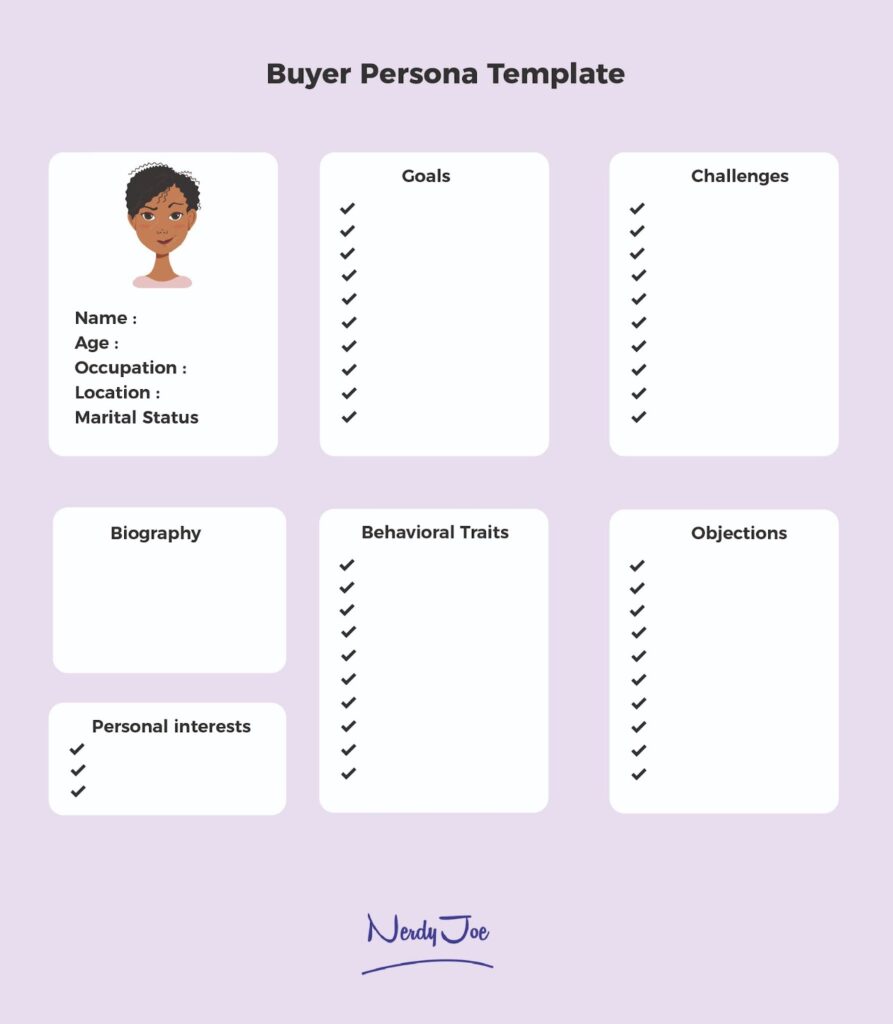
Here are two tools you can use to build buyer personas for your ideal customer. These also include buyer persona templates for different target customers.
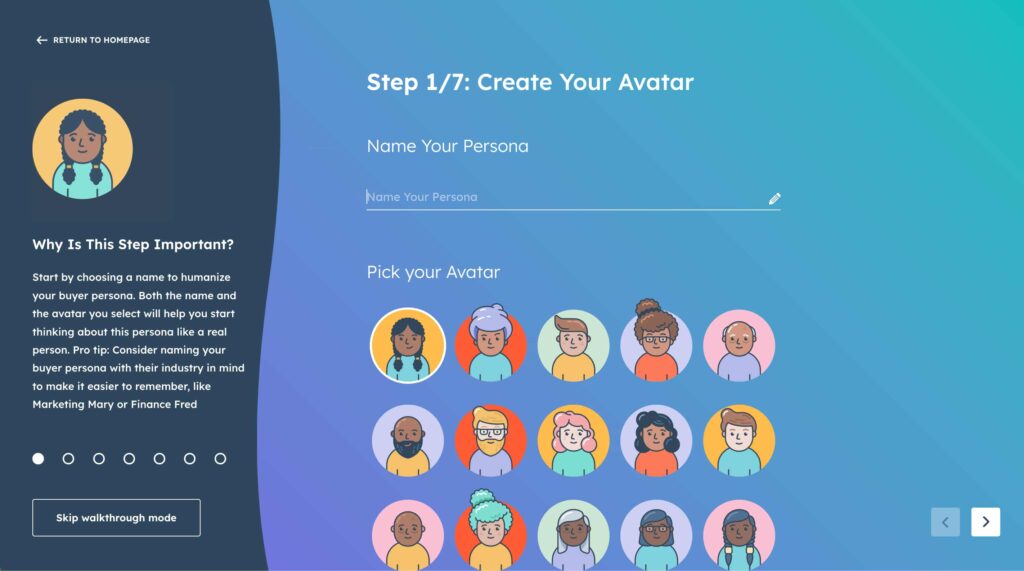
This tool asks you questions about your target audience and lets turn the answers into beautifully-designed customer personas for your sales and marketing teams.
You can create multiple buyer personas to make sure that you cover all your audience personas.
2. SEMrush Buyer Persona Templates Creator
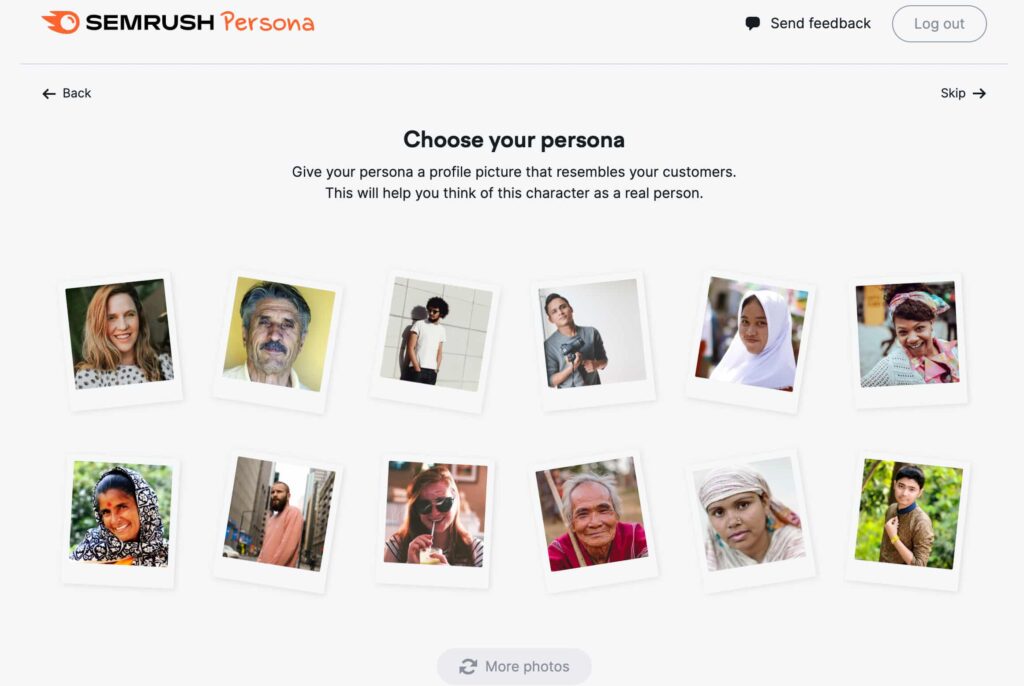
SEMrush also offers a tool that lets marketing and sales teams easily create buyer personas.
It works almost in the same way as that of HubSpot and helps businesses quickly whip up personas of their prospective customers.
Here also you can create different buyer personas to multiple personas.
Five email marketing customer persona examples for your sales team
The buyer persona creation process may be challenging for most people seen as there is a lot of information you need research about your ideal target customer.
Creating buyer personas based on examples is an effective way to ensure you create a buyer persona that truly fits the potential customers for your marketing and sales team.
Buyer persona example 1: Brandi Tyler
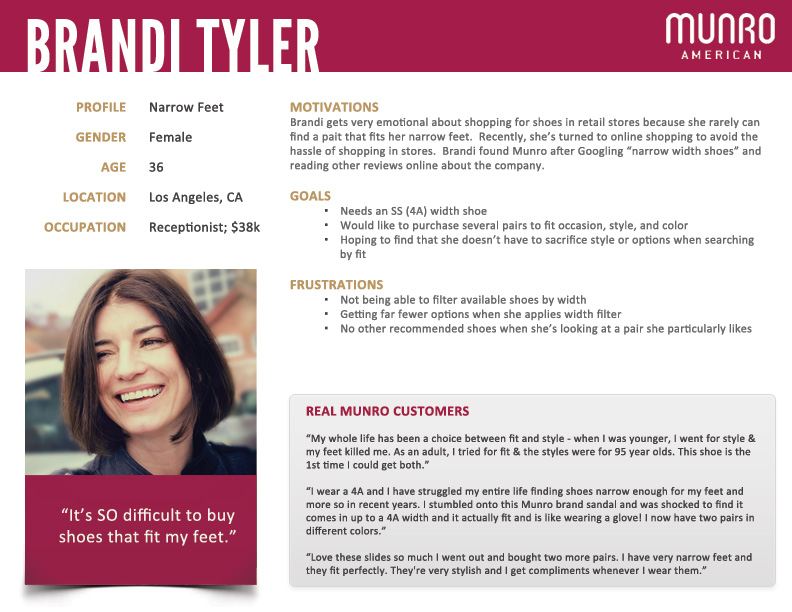
This template is a great example of what a buyer persona looks like. It is detailed and describes the customer vividly.
Not only does it consist of a great layout and design, but it also includes quotes from the customer, Brandi.
From the persona, we understand a lot about the customer — her pain points (shoe size) and her goals.
Buyer persona example 2: Hector Cortez
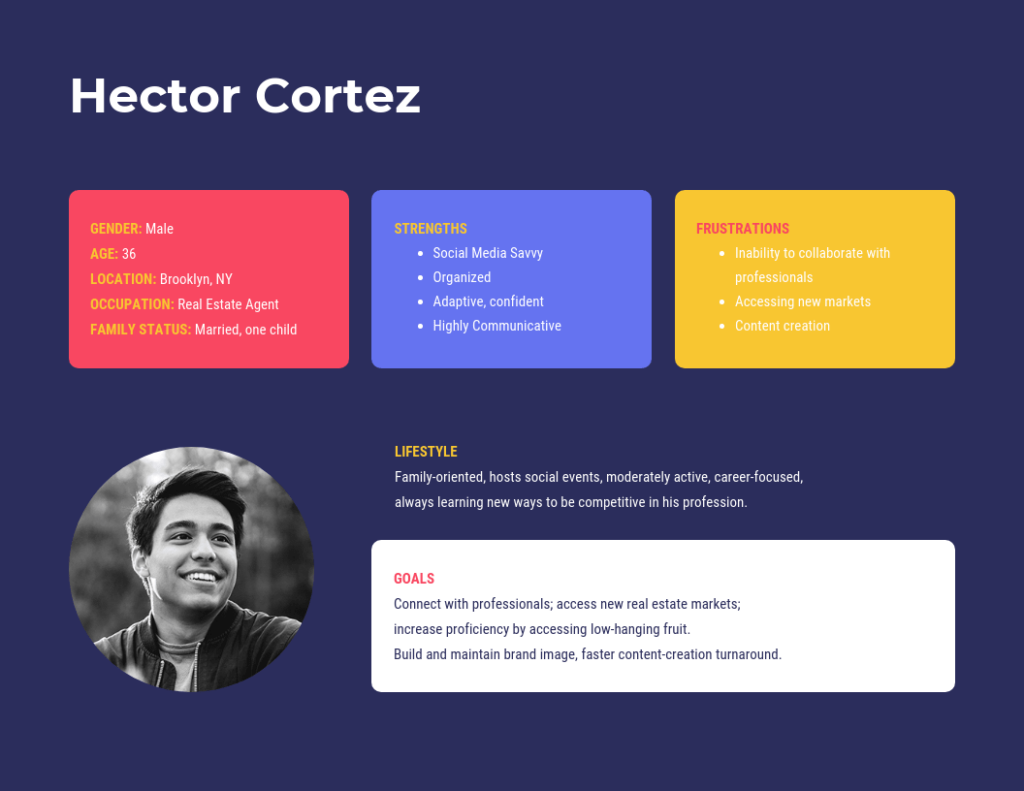
In this template, the layout is what describes the details. It shares vital information without being wordy.
This makes it perfect for a marketer who has little time and has to check other personas. Creating a template like this can save you time and make your messages precise.
Buyer persona example 3: Sarah Student
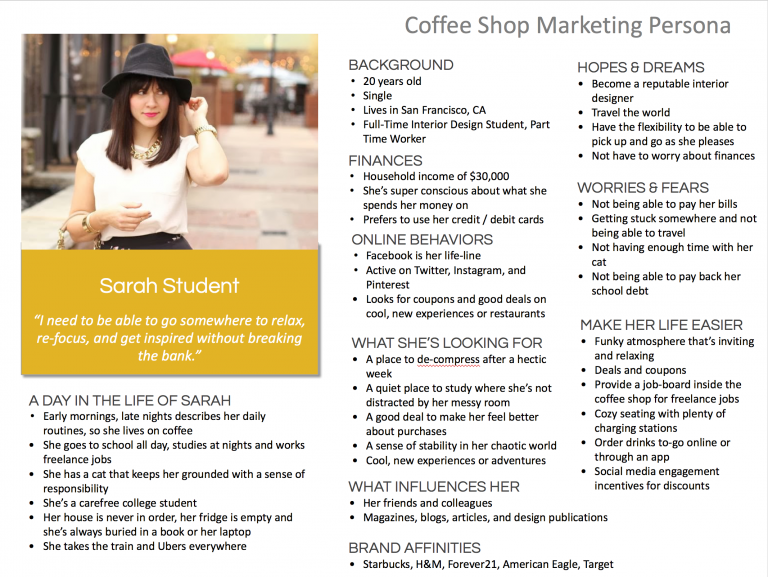
If you want something more detailed than the previous example, this Sarah student persona is a perfect example. It is explicit and provides an in-depth understanding of the customer.
Here, we know about crucial details such as her background, hope, fears, and more. We also know about her influences, finances, and brand affinity which can help us shape our email marketing strategy.
For instance, from the “make her life easier” category, we can see she lives deals and coupons. In other words, she appreciates incentives and that can help you craft relevant content when sending her an email.
Buyer persona example 4: Tracy Chadwick
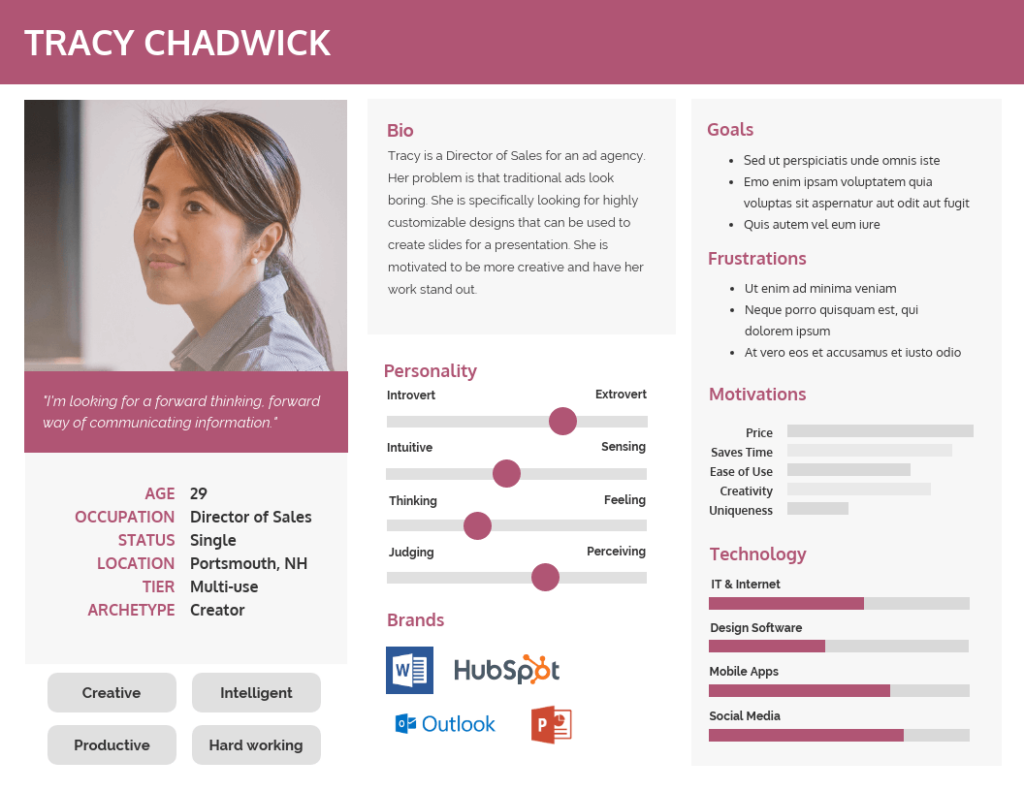
An outstanding feature of the template is the layout and design. It caught his attention while highlighting crucial details about the customer.
Here, we can see her personal information such as age, status, location, and more. It also includes diagrams and charts that describe who the customer is.
Then, there are succinct details about the customer’s goals and frustrations.
Buyer persona example 5: Janelle Robinson
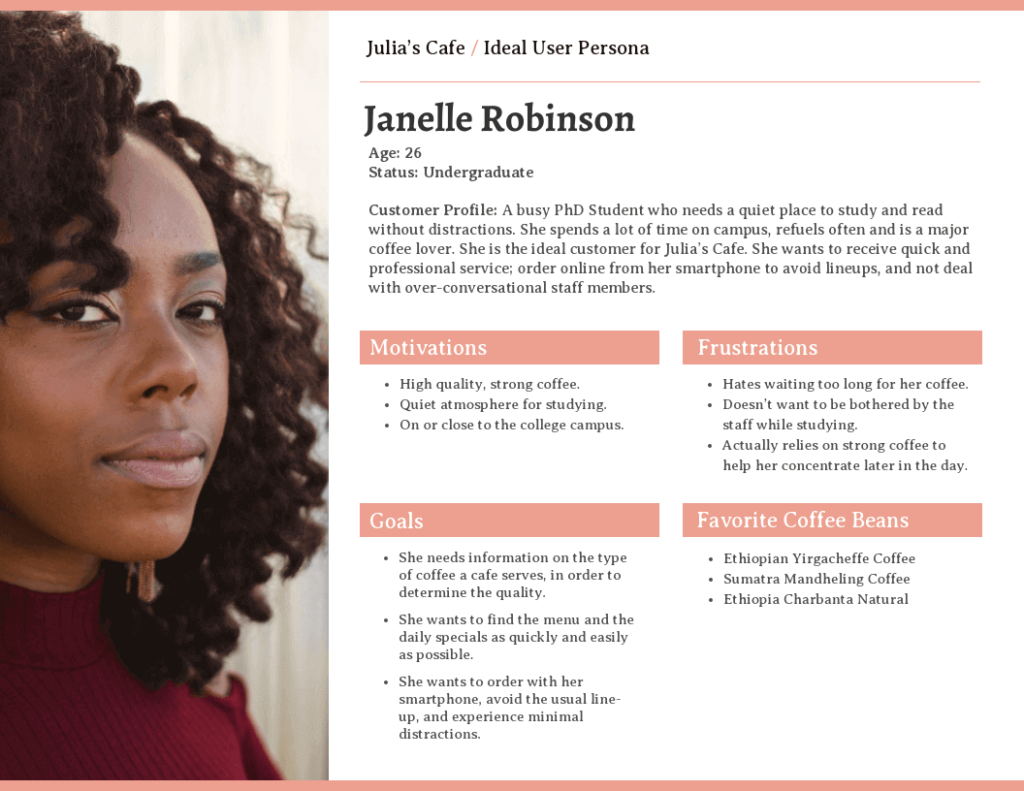
This buyer persona is another great example. It includes a customer’s details such as her age, status, and bio.
It also highlights her needs and pain points which involve looking for a café that allows her to study quietly and get a coffee without waiting too long in the queue.
This is great info for any marketer in the café industry seeking to advertise some coffee to her.
Key Takeaways
- A buyer persona is a semi-fictional representation of your ideal customers.
- A buyer persona helps you to better understand your audience, thereby creating relevant content that suits their needs. Always consider how many buyer personas you need to create for your teams and seperate each persona template you create.
- You can profile your customers through various factors such as their details, career path, shopping preferences, and more.